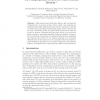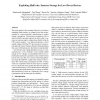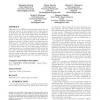34 search results - page 3 / 7 » Data Remanence in Flash Memory Devices |
DAC
2011
ACM
12 years 5 months ago
2011
ACM
Flash memory is quickly becoming a common component in computer systems ranging from music players to mission-critical server systems. As flash plays a more important role, data ...
WEA
2009
Springer
13 years 10 months ago
2009
Springer
Flash memory-based solid-state disks are fast becoming the dominant form of end-user storage devices, partly even replacing the traditional hard-disks. Existing two-level memory hi...
JCIT
2007
13 years 5 months ago
2007
Recently, a flash memory has become a major database storage in building portable information devices because of its non-volatile, shock-resistant, power-economic nature, and fast...
FAST
2011
12 years 9 months ago
2011
This work analyzes the stochastic behavior of writing to embedded flash memory at voltages lower than recommended by a microcontroller’s specifications to reduce energy consum...
CF
2010
ACM
13 years 5 months ago
2010
ACM
Solid-State Drives (SSDs) are data storage devices that use solid-state memory to store persistent data. Flash memory is the de facto nonvolatile technology used in most SSDs. It ...



